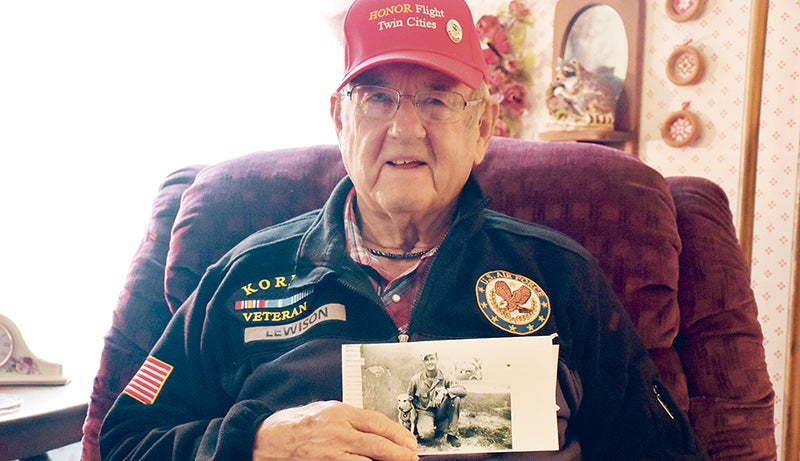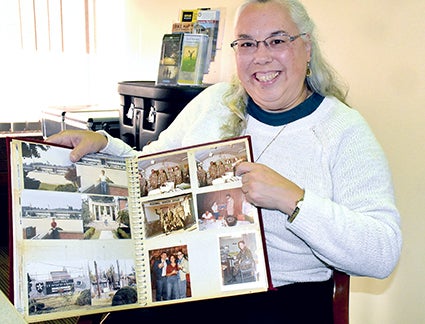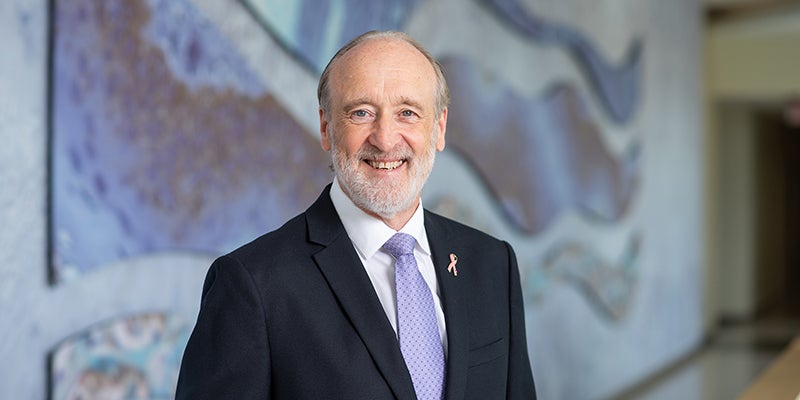Veterans share their stories
Published 9:20 am Friday, November 10, 2017

- Maynard Lewison holds a photograph of himself and his dog, Queenie, while he was stationed in Guam. Photo by Michael Stoll/mike.stoll@austindailyherald.com
Many Mower County men and women have proudly served in the United States Armed Forces. In honor of Veterans Day, here are a few of their stories.
Airman First Class Maynard Lewison
Maynard Lewison of Adams was 17 years old when he received his draft notice in 1951. Lewison hoped he could work in a motor pool or as a mechanic, but to do so meant he would have to serve four years in the U.S. Air Force, U.S. Navy, or U.S. Marine Corps.
“I picked the Air Force and they said, ‘Well, what do you want,’ he recalled. “I said to work in the motor pool. They said, ‘Well, we got one question: Do you know the firing order of a six-cylinder engine?’ I said ‘one, five, three, six, two, four.’ The guy looked at me and said, ‘Where did you get that from?’ and I said, ‘That’s the truth.’ He said, ‘You’re right.’”
Lewison was sent to Lackland Air Force Base in Texas for basic training in 1952.
“It was different when you’re 17 and go into the service,” he said. “You just do what you’re told and keep your nose clean.
“One day when we were marching, we were given the order ‘to the left oblique movement’ (half turn) and I didn’t understand him. I thought it was a full turn, then people ran into me and I screwed it all up.
“So the sergeant came up to me, reached down and found a rock and said I would carry this with me the rest of my basic.
Everyday he inspected that rock and I kept it in my right hand all the time.”
Lewison was then sent to Fort Ord in California for advanced individual training. After eight weeks, he was stationed in Salina, Kansas, before receiving orders to deploy to Guam in 1953.
“I took my car home, an old beat-up Ford,” he said. “I left the car home and had one date with my (future) wife on Sunday, then Monday morning I took off and went overseas.”
While in Guam, Lewison was responsible for maintaining the seven generators that furnished all power to the control tower, base operations, and ground communications approach for the airstrip at Anderson Air Force Base.
“Every plane that came in had to be set down by the radar because we only had 8,886 feet of runway,” he said. “From there on you get your feet wet.”
While in Guam, Lewison found a companion in the form of Queenie, a golden Labrador retriever that he called his “lifeline.” She kept him company while he was alone on the north end of Anderson Air Force Base.
Although Lewison saw no combat during his time in the Air Force, he was not completely out of danger.
“They made me have my rifle with me because the Japanese were still in the jungle,” he said. “They sent pamphlets out once a month and dropped them for the Japanese to read and told them it was safe and they could come out because (World War II) was over and they could go home. Once in awhile they’d get one.”
Another danger came from the weather.
“When we got typhoons, I’d have to move the radar site in when the winds got to 95 miles per hour,” he said. “We couldn’t move them until then because we had to keep the runway open.”
Lewison was discharged as an Airman First Class in February 1956. He returned home to Adams, where he married his late wife, with whom he had three daughters. He worked in heavy equipment with Osmundson Brothers in Adams before retiring.
Recently, he was one of 74 Minnesota veterans who got to participate in the Honor Flight to Washington, D.C.
“When we walked into the airport (in Washington, D.C.), it was like the world came to an end; people standing all over and greeting us,” he said. “I’ve never been treated like that in my life. Some of the men and women would jump out of the line standing alongside of us and give you a hug and shake your hand, and then a big choir sang the National Anthem and all of the branch songs. Al Franken was there and he shook our hands. They treated us like royalty.”
The veterans went to various sites, such as the Air Force Museum and the World War II, Korea, and Vietnam War Memorials.
“It was the trip of a lifetime,” Lewison said. “I hope more veterans get to go on it.”
Major Eileen Chao
Anyone who has visited the Discover Austin office on Main Street has probably run into Eileen Chao. But before she was promoting events in Austin, she was wearing the nation’s uniform.
“I went to basic training at the end of 1982 at Fort McClellan, Alabama,” she said. “After basic I went straight to Fort Benning, Georgia, for Officer Candidate School (OCS). “
Chao joined the Army because she “needed to get something more.”
“I already had my masters degree in 1982 and there was a recession,” she said. “I had been working in Washington, D.C., at Georgetown in the registrar’s office. I moved back to Minnesota thinking I could find a job, but there were no jobs. I worked in a temporary job for a few months and they put me on four-day weeks, so the fifth day I went job hunting. The first time I went out, I saw the ‘I want you’ posters, so I talked to the Air Force, Navy and Army. The Army was the one that was the most credible and interesting to me, so when I went in and talked to them, they noticed my academic background and said I should go straight in as an officer.”
Chao was injured during her first attempt at OCS and put on a hold status, but passed the second time in 1983. Her specialty was the Adjutant General Corps, which she described as “the Army’s human resource department.”
After OCS, Chao was assigned to Camp Casey in South Korea.
“My dad had been a MASH (Mobile Army Surgical Hospital) doctor in Korea, so I looked at all of his old photo albums and talked to him about it,” she said. “When I got (to Korea), I did not know where I was going to be assigned. I was sitting in Seoul waiting and they finally said I was going to be sent to Camp Casey, Second Infantry Division, and I said, ‘I’m not infantry.’ It was a huge culture shock. It looked like the pictures my dad took, and I was there 30 years later.”
Chao arrived at Camp Casey to find a run-down facility.

Eileen Chao holds an album displaying photographs from when she was stationed in South Korea. Photo by Michael Stoll/mike.stoll@austindailyherald.com.
“When I got there, it was after (President) Carter had cut all of the funds because he was going to close it down and pull people back,” she said. “It was in terrible shape. Everything was beat up. I ended up with the largest section in the adjutant general unit, 60-80 people in this huge building. It’s the end of November and it was cold, and in this building were all of these soldiers bundled up with every bit of clothing they had trying to work. As I walked around the building, there were holes the size of people’s heads to the outside. When Carter had made that decision, all of the money stopped, so there was no maintenance or repairs. It was horrible. When I got there, (President) Reagan had said we weren’t leaving, but the money hadn’t started cycling in yet, so it was very primitive when I got there.”
After a year in South Korea, Chao was moved around to various assignments. She was stationed at Fort Meade in Maryland, then in the Netherlands during Operations Desert Storm/Desert Shield. She taught French at the United States Military Academy in West Point, New York, for three years, after which she was stationed in Germany with the First Armored Division for three years. While stationed in Germany, she was briefly sent to Croatia. Her final assignment was working with the Army Reserves in Indianapolis.
She retired from the Army as a major in 2002.
“(Getting back to civilian life) was very weird,” she said. “I got out in Indianapolis, then moved back to Austin, not in a military environment.”
Chao was employed as a security guard for the Hormel plant before working for IBI Data in Brownsdale and later Staples. She started with Discover Austin in 2010.
Although she enjoys her job, she still has fond memories of the Army.
“In general, the people that go into the Army and stick with it, they’re special because they have a goal, a mission and they’re focused on it,” she said. “They’re very conscientious and I loved working with the people there. To me, it was a great life. It was a mission people believed in. There are still several people I keep in touch with.”
Today, Chao is an active member of the American Legion Spam Post 570 in Austin.
“Being in the military is a great career,” she said “It’s not for everybody, but for the people that go in, I think it’s very fulfilling. You learn a lot, you get exposed to a lot, you get to travel, and you get to meet people all over the place. It really broadens your view of the world.”
Capt. Jim Weber
Jim Weber’s life in the Army began in April 1953 when he went to basic training at Fort Riley, Kansas. The Korean War was going on at the time, and as far as he was concerned, that was where he was going,
“They were preparing us to go to Korea,” he said. “We had gotten our shots and though we were going to go, but then the armistice was signed, so we didn’t.”
During basic training, Weber was assigned to the 87th Infantry Regiment of the 10th Mountain Division. He was then sent to Fort Carson, Colorado, where he joined the Fourth Field Artillery Regiment.
“Our weapons were transported by mules,” he recalled. “We were the last unit in the Army to be outfitted with animals.”
Weber’s active duty service continued in Colorado for three years, where he alternated between the Fourth Artillery at Fort Carson and the 97th Artillery at Camp Hale.
In 1956, Weber joined the U.S. Army Reserves and was attached to a military police unit in Austin. He was a sergeant when he joined the Minnesota Army National Guard in 1958. He went to the Minnesota Military Academy at Camp Ripley to train as an officer.
“I joined the National Guard specifically to go to Officer Candidate School,” he said. “It wasn’t until later that I found out I could have received a direct commission because of my experience. But, I enjoyed OCS. I got a kick out of the tactical officers because I was older than most of them and was already a police officer in Austin.”
While serving in the National Guard, Weber worked as a police officer until 1966, when he left as a sergeant. He then started an insurance claims business. His only reminder of military life was the monthly weekend training and the two weeks spent training in the summer. But when the Vietnam War was in full swing, the possibility of getting deployed was very real.
“There was a lot of thought of that,” Weber said. “We were drilling twice a month at that point and the officers were doing a lot of recruitment work since recruiting was really difficult at that time. They were expecting to activate us, but the end came and we didn’t go.”
Weber retired as a captain in 1979. For him, the transition from military to civilian life was not too difficult.
“I guess in a way I was always a civilian,” he said. “I just didn’t have to go to drill or summer camp anymore.”
Weber was recently one of 74 Minnesota veterans to participate in the Honor Flight to Washington, D.C. It was his second Honor Flight, his first being as a guardian to a World War II veteran. This time, he went as a veteran with his daughter as his guardian.
“They can’t do enough for you,” he said of his experience during the recent Honor Flight. “It’s a great trip. The only negative is that it’s all in one day, which makes for a long day.”




